Harvesting on time: when to harvest pumpkin and how to determine its ripeness in the garden
Harvesting pumpkin is the most enjoyable process for the gardener. And if the fruits are ugly, then doubly. Pumpkin is loved for its rich content of vitamins and microelements, but due to the mistakes of vegetable growers, its benefits are lost. If you overexpose the pumpkin in the garden, it can freeze slightly. The taste and shelf life of a vegetable largely depend on the harvest period.
How do you know when a pumpkin is ripe? By what varietal and individual characteristics to determine maturity? When to harvest according to the lunar calendar? You will find detailed answers to these questions in our article.
The content of the article
When to harvest pumpkin
A mid-season pumpkin variety ripens for about 4 months. Harvest in mid-September. A prerequisite is to have time to cut off all the fruits before the onset of frost. Otherwise, the pumpkin will quickly freeze and spoil.
Harvested on a dry, fine day. If the fruit is removed during a rainy period, the fruits are dried and left for several days in a dry, dark place.
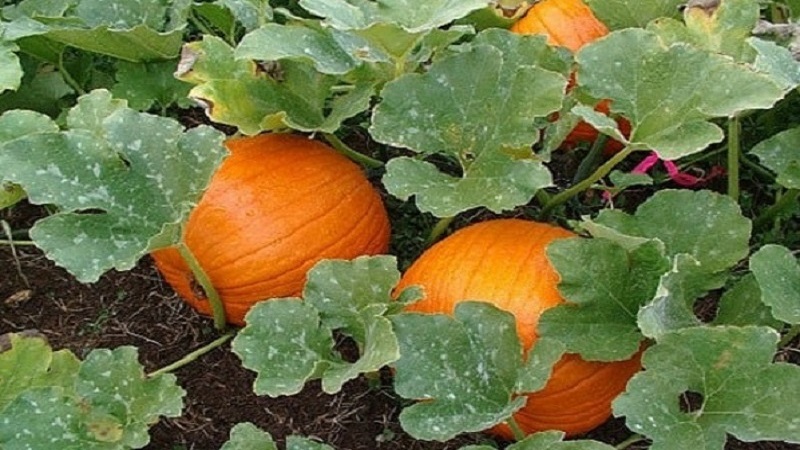
What determines the ripening time
There are early ripening, mid-ripening and late-ripening varieties. Each of them differs in the speed and conditions of ripening.
The climate plays a key role in the fruiting of plants:
- in the southern regions on the open ground, it is customary to harvest when all the leaves dry up;
- in the northern regions, the fruits do not have time to ripen, they are removed ahead of time and sent to ripen indoors.
How to understand that the pumpkin is ripe and it's time to harvest
How to determine the ripeness of a vegetable in the garden? For beginner gardeners, it is especially important to know the signs of the readiness of the fruit for consumption or storage. Be guided by external manifestations. Do not break the integrity of the fruit and do not try to pierce or cut it, otherwise it will quickly deteriorate.
Important! You can remove vegetables only with a knife, carefully cutting it off from the stalk. Do not pluck the pumpkin or leave ragged ends on the tail - this will cause soreness to the fruit and plant.
Individual signs of fruit ripening
You can check the ripeness of the pumpkin without removing it from the garden. Depending on the variety, each plant signals the ripeness of the fruit differently. It is enough to take a closer look at the vegetable bark:
- bush varieties are distinguished by clear light yellow stripes;
- a large-fruited pumpkin has a dark, dense mesh;
- the bark of muscat varieties becomes brown with light round spots.
External manifestations
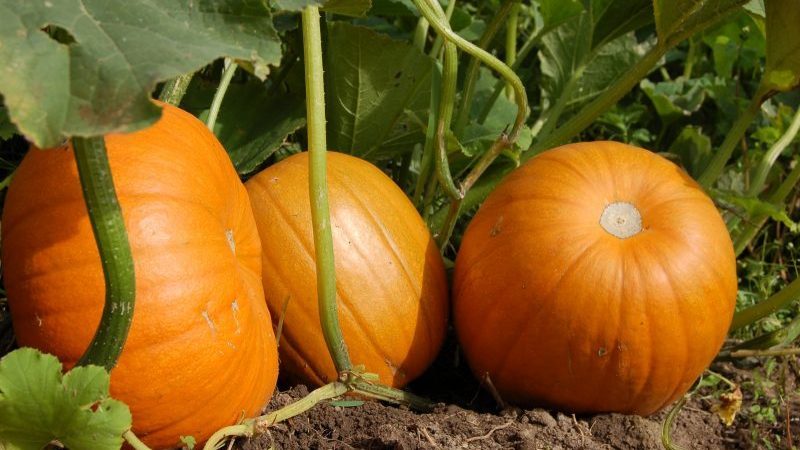
External criteria for pumpkin ripeness:
- The peduncle is dry, hard, tough. If it is still green, let it ripen.
- Leaves and whips on the plant are yellowed and dry (at least partially).
- Pumpkin has a rich color, depending on its variety - yellow, gray-green or dark orange. There are some varieties that are not covered by this rule. There are plants whose fruits remain white or gray even when fully ripe.
- Fruit crust is hard and firm. When pressed, there should be no dents on it.
- The shell of ripe fruits has a pronounced pattern. The exception is green-fruited varieties.
- Dense pulp structure.
- Hard seed skins, excluding gymnosperms.
Reference. Some gardeners recommend focusing on the sound when tapping. If it is sonorous, the pumpkin is ripe.
With this simple knowledge, you can easily find out the time of harvesting in your garden.Wherever he is, in the Kuban, in Siberia, in the Leningrad, Moscow regions or in the Urals - these criteria are universal.
Harvest only ripe fruits. If you still need to harvest ahead of time, leave them to ripen in a warm, dry place.
For the convenience of gardeners, producers write the harvest dates on the back of the seed bag. Sometimes the description indicates the color of the ripe fruit.
Important! The period indicated by the manufacturers will be accurate only if the summer is warm and sunny.
Harvesting calendar dates
Pumpkin harvesting dates depend on the local climate and plant variety:
- in Siberia, the harvest is taken from the end of August;
- in central Russia and Ukraine - in mid-September;
- in the Krasnodar Territory - until early October.
The pumpkin should be harvested on a clear, dry day. It is desirable if it coincides with the collection date according to the lunar calendar.
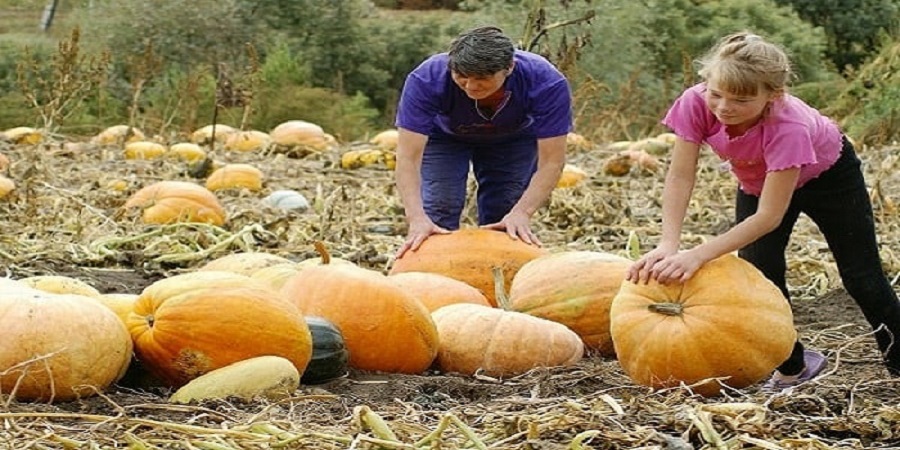
Lunar cleaning
Experienced gardeners carry out all the work on the site, according to the lunar calendar. It turns out that even harvesting has its auspicious days - during this period, all plant juices move to the fruit, saturating it and giving it taste.
The lunar calendar changes every year. The most favorable dates for collecting pumpkins will be the days when the Moon is in Gemini in a waning phase, Scorpio in a waning phase, Sagittarius, Capricorn and Aquarius in any.
Pumpkin varieties and ripening dates
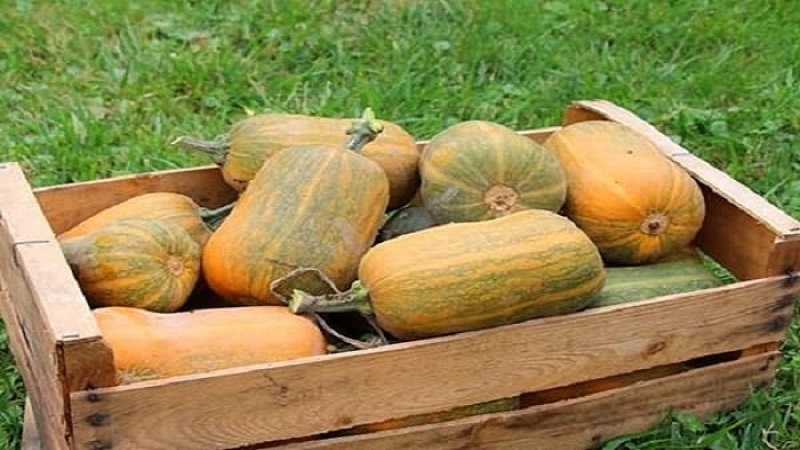
There are many pumpkin varieties, but there are universal harvesting dates:
- Early ripening - Mozoleevskaya 49, Golosemyannaya, Almond35, Biryuchekutskaya 27, Vesnushka, etc. They ripen within 3.5 months, and they are harvested in mid - late August. The fruits are quite tender, have a thin crust, so they are stored for no more than a month. Early ripening varieties are often grown in cold regions: in case of frostbite, they are not stored for a long time.
- Mid-season — Smile, Winter sweet, Chit, Volzhskaya gray, One hundred pound, Therapeutic, Russian woman and others. Ripening period - 4 months. The pumpkin is harvested in mid-September before the first frost appears.
- Late ripening (hard) - Muscat, Pearl, Vita, Testi Delipe, Interception, Vitamin and Butternat Ponca. Stored up to six months due to the thick crust. Fees are held in mid - late September. The ripening period is about 200 days, so the pumpkin ripens during storage.
Storage of the harvested crop
Before leaving the harvested crop for storage, it is advisable to sort the pumpkins by volume into large, medium and small... Experienced summer residents are advised to leave fruits only of medium and large sizes, without damage.
How do you know if a pumpkin will rot during storage? If certain conditions are met, it will remain fresh throughout the winter. At a temperature of 25-28 ° C and a humidity of 80-85%, unripe pumpkins will ripen, the skin will harden, and scratches that can cause rotting will heal. If you do see damage, try to heal it by treating it with 3% potassium permanganate.
After a week, it is advisable to transfer the pumpkin to a cool dry place, preferably with good ventilation. Favorable storage conditions for the remaining time - temperature + 4… + 9 ° C and humidity - 70%.
Owners of private houses can use cellars for planting crops, residents of megalopolises have adapted to store vegetables on the balcony or in the basement.
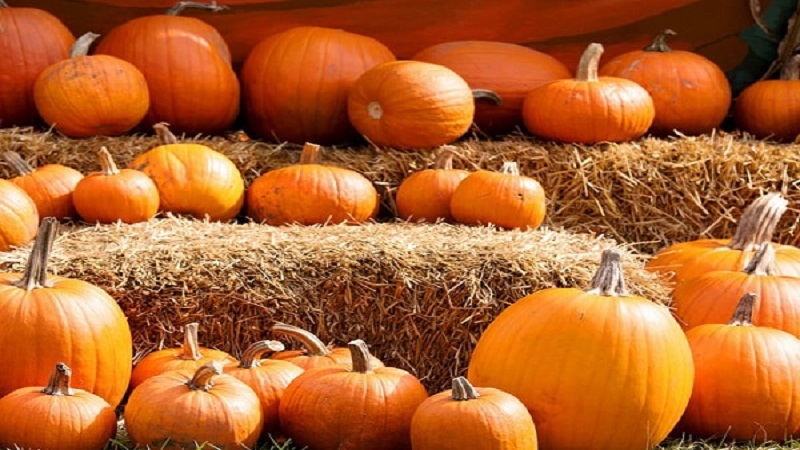
In addition, there are a few more recommendations to help you preserve your harvest for the winter:
- arrange pumpkins so that air circulates between them;
- it is most convenient to store pumpkins on racks, placing straw under them;
- by looking after the storage 2 times a week, you can immediately notice rotting fruits and protect the rest;
- do not store pumpkin next to fruit.
Reference. Gardeners note the best preservation in such varieties as Almond 35, Mozoleevskaya 49, Premiera and Gribovskaya Zimnyaya.
Tips from experienced gardeners
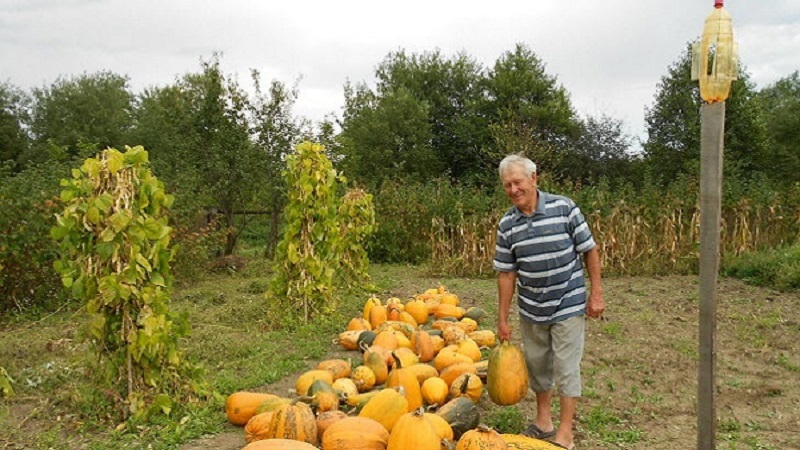
Growing pumpkin has its own tricks:
- The last time to water the vegetable should be 3 weeks before harvest.
- In rare cases, you can check the ripeness of the pumpkin by pressing on it with your fingernail. If the peel is pressed through and is green inside, then it has not ripened. But such a test is fraught with rotting of the entire fruit.
- If there is not enough storage space for vegetables, you can cut the pumpkin into pieces and freeze it. This blank is used to prepare all dishes, except pumpkin juice. Drying and drying of vegetables is also popular.
- The pumpkin should not be kept until spring. In this case, it begins to stale and become "cottony", losing its taste and juiciness.
- If the season was cold and rainy, harvest time has come, and the pumpkin is not yet ripe, you can speed up this process. 3 weeks before the first frost, all the flowers from the pumpkin must be removed, and the tops of the young shoots must be pinched. To speed up the ripening of large fruits, all small pumpkins are removed from the bush.
Conclusion
Pumpkin is an unpretentious culture, it grows in most dachas and vegetable gardens in Russia. It doesn't take much effort to grow it. But to know at least the basics of caring for a vegetable is necessary. Determining the maturity of the fetus is a simple exercise. It is enough to know the varietal characteristics of pumpkin and take a closer look at the plant and the vegetable itself.
It is important to harvest the crop before the onset of frost, otherwise the fruits will freeze. Follow our helpful guidelines and get good yields every year!